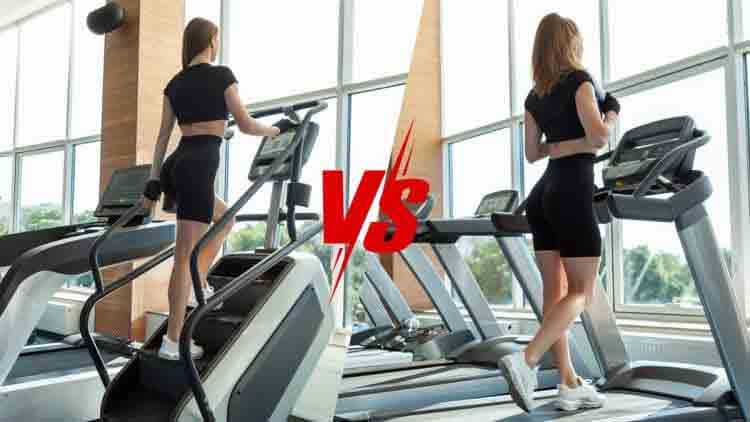Hi, I’m Steve,
A balanced fitness program includes spending time doing cardio. Whether you train in a commercial gym or set up your home gym, you will have plenty of cardio options. So, knowing which one to choose to get the best bang for your buck is crucial.
Two of the most popular cardio machines are the treadmill and the Stairmaster. Both are great for cardiovascular training, but which is better? Find out in this head-to-head comparison.
Stairmaster vs. Treadmill Overview
To make an educated decision between the Stairmaster and the treadmill, you need to know key facts about both. Here are the key areas we’ll cover:
- Use cases
- How to perform each exercise
- Muscles involved
- Advantages and disadvantages
- Muscle-building ability
- Calorie-burning ability
- Impact on joints
- Final verdict
Stairmaster vs. Treadmill Comparison
Here is everything you need to know to champion a Stairmaster vs. treadmill debate:
1. Use Cases: Stairmaster vs. Treadmill
Walk into any gym, and you’ll probably find the cardio area packed. More and more people are flocking to gyms to use treadmills, ellipticals, rowing machines, and Stairmasters to burn calories, shape up and improve their cardiovascular health.
Modern cardio machines have become mini entertainment centers with built-in screens, streaming services like Netflix, and workout programs to keep users engaged. However, you need to look beyond the bells and whistles if you’re looking to buy a single piece of cardio equipment for home use.
Things to consider when buying a Stairmaster or treadmill for home use:
a. Space
You probably have limited space in your home gym. Yet, your cardio machine will likely be one of the largest pieces of gear in your iron paradise. Both a treadmill and a Stairmaster are pretty bulky, though the treadmill is longer and takes up more space.
Stairmaster models vary slightly in size, but their typical dimensions are 58 inches (147cm) long x 34 inches (86 cm) wide x 89 inches (226 cm) high. A Stairmaster requires a ceiling height of ten feet. In comparison, the average dimensions of a treadmill are 77 inches (196 cm) long by 35 inches (89 cm) wide.
b. Cost
An average Stairmaster costs $4,900. On the other hand, a home treadmill can cost anywhere between $300 to $3,500. For between $300-700 you can purchase a no-frills budget treadmill. A middle-of-the-range treadmill will cost you between $800 and $1,800, while a high-end model with a wide running belt, top speed of 12 miles per hour, and advanced monitor will cost between $2,000-3,500.
2. How To Perform: Stairmaster vs. Treadmill
Exercising on a treadmill is relatively easier than on a Stairmaster. Here are some key tips to ensure that you are working out with the proper technique on each machine.
Treadmill Running Tips
Running on a treadmill takes some getting used to. Having the ground move under your feet requires more balance and coordination than running outdoors. Here are some tips to help you get it right:
- Run with your toes pointed forward: Avoid turning your foot out as you strike the ground as this can strain your knees. Start off slow until running with toes pointing forward becomes second nature.
- Maintain an upright torso: Engage your glutes, maintain a neutral lower back position, and keep your shoulders down and chest up. Don’t allow your body to slump as you get fatigued.
- Swing your arms: Use a natural back-and-forth swinging motion with your arms. Don’t allow your arms to cross the midline of your body.
- Do not hold onto the handrails: The rails are designed to help you get on and off the treadmill, not to be held while exercising. If you do, you won’t be able to maintain an upright position. Holding the rails also makes the exercise easier, reducing your calorie-burning potential and the overall effectiveness of your workout.
- Stride out: Run with a full, natural gait. Do not use short, stuttering steps. Avoid overstriding, or you’ll get ahead of your body’s center of gravity and create a braking force.
- Don’t get off when the treadmill is moving: Always wait until the running belt has stopped moving.
Stairmaster Tips
Make the most of the Stairmaster with the following tips:
- Maintain an upright spine: Tense your glutes, contract your core and keep your lower back naturally arched. Pull your shoulders back and chest up. Many people tend to hunch forward as fatigue sets in, putting stress on the lower back. If you feel that happening, squeeze your glutes and pull back your shoulders.
- Drive through the heel: Rather than just making contact with your toes, place your entire foot on the step and drive through your heel. This will emphasize the glutes rather than overloading the calves.
- Don’t hold on: Do not grab the safety rails as it will reduce the load on your muscles and the machine’s effectiveness.
- Go backward and forward: When you step facing the machine, the emphasis goes on the glutes and hamstrings. But when you turn around and face away from the machine, the emphasis goes on the quadriceps. Mix it up for a wholesome Stairmaster workout.

